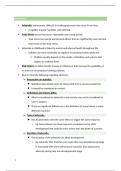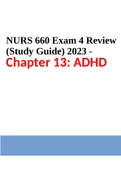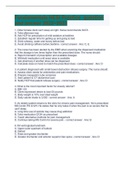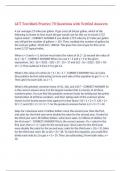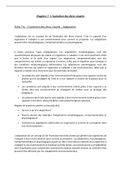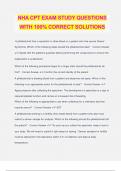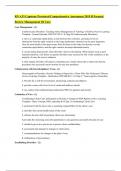ADVERSITY
Adversity: Unfortunate, difficult, or challenging events that occur in our lives.
o It signifies trauma, hardship, and suffering.
Toxic Stress: Stress that occurs repeatedly over a long period.
o Toxic stress has mental and physical effects that are significantly more harmful
than those of non-toxic stress.
Adversity in childhood is linked to mental and physical health throughout life.
o Children are more vulnerable to negative circumstances than adults are.
Children usually depend on the people, institutions and systems that
neglect or maltreat them.
Risk factors are determinants (causes or influences) that increase the possibility of
an event or circumstance harming children.
Bear in mind the following regarding adversity:
Perspective on statistics.
Statistical data should never be interpreted from a narrow perspective.
It should be considered in context.
Definitions and Criteria differ.
What is considered an adversity in one society may not be considered as
such in another.
There are significant differences in the definition of sexual abuse in many
different countries.
Type of adversity.
Not all adversities exert the same effect or trigger the same response.
o Eg. Sexual abuse may have long-term consequences for child
development that could be more severe than the death of a parent.
Duration of adversity.
The duration of the adversity can affect development.
o Eg. Adversity that stretches over more than one developmental stage
is associated with worse behavioural outcomes than exposure to
adversity during only one developmental stage.
1
, Critical period.
The developmental status of children at the time they are exposed to adversity
can influence the intensity and extent of the effect significantly.
o Eg. Exposure to various forms of adversity during early childhood is
associated with alterations in brain development, which in turn is
associated with psychological and physical health consequences that are
more long-lasting.
The number of adversities and interactions.
The risk of adverse mental and physical health consequences increases as a
function of the number of categories of adversities to which people are
exposed.
It is a tragic fact that when it comes to severe adversity (e.g., maltreatment),
most children are exposed to more than one form of adversity at a single point
in time.
o Eg. A child may be abused sexually, live in extreme poverty, and be
exposed to drug and alcohol abuse simultaneously.
The multiple forms of adversity may act in interactive and complex ways to
intensify negative development over time.
o Known as polyvictimisation.
Supportive systems and relationships.
Children develop in an environment of systems and relationships.
Supportive systems can buffer the child’s response to adversities.
Pre-existing characteristics.
Many of the adversities happening to children do not occur at random.
They usually occur more often in children and families with pre-existing
vulnerabilities linked to biological or environmental influences that pave
the way for adversities to occur.
o Eg. Alcoholism has a strong genetic component that makes family
members more vulnerable to alcohol abuse.
2
, Individual variation.
Children may have different psychological and physiological reactions to
the same stressor because of the already mentioned unique interaction
between environmental and biological variables in every child.
The sleeper effect.
Reactions to a traumatic event do not necessarily occur immediately after the
event.
o They may appear days or weeks (in exceptional cases, even years) after the
event.
Eg. Survivors of abuse in childhood can have a delayed response triggered by
something that happens to them as adults.
The more frequently violence was witnessed, the more aggressive the
behaviours became.
Divorce
Divorce can affect children significantly.
Findings regarding the effects of divorce on children:
o More children from divorced homes are affected seriously by their parent’s divorce.
Includes emotional problems, behavioural problems, scholastic underachievement,
and interpersonal problems.
o Most children from divorced families see divorce as an acceptable solution to an unhappy
marriage, even when children are present.
The probability of the marriages of the children of divorced parents ending in
divorce is also higher than for children of intact families.
o Relationships between children and their fathers are affected negatively by divorce more
often than the relationships between children and their mothers are.
Most children from divorced families report poor relationships with fathers, which is
in sharp contrast with children from intact families.
o Children of divorced parents tend to have lower levels of educational, occupational, and
financial attainment than children from intact families.
o Children of divorce are more likely to reject faith and religious involvement as adults.
3
Adversity: Unfortunate, difficult, or challenging events that occur in our lives.
o It signifies trauma, hardship, and suffering.
Toxic Stress: Stress that occurs repeatedly over a long period.
o Toxic stress has mental and physical effects that are significantly more harmful
than those of non-toxic stress.
Adversity in childhood is linked to mental and physical health throughout life.
o Children are more vulnerable to negative circumstances than adults are.
Children usually depend on the people, institutions and systems that
neglect or maltreat them.
Risk factors are determinants (causes or influences) that increase the possibility of
an event or circumstance harming children.
Bear in mind the following regarding adversity:
Perspective on statistics.
Statistical data should never be interpreted from a narrow perspective.
It should be considered in context.
Definitions and Criteria differ.
What is considered an adversity in one society may not be considered as
such in another.
There are significant differences in the definition of sexual abuse in many
different countries.
Type of adversity.
Not all adversities exert the same effect or trigger the same response.
o Eg. Sexual abuse may have long-term consequences for child
development that could be more severe than the death of a parent.
Duration of adversity.
The duration of the adversity can affect development.
o Eg. Adversity that stretches over more than one developmental stage
is associated with worse behavioural outcomes than exposure to
adversity during only one developmental stage.
1
, Critical period.
The developmental status of children at the time they are exposed to adversity
can influence the intensity and extent of the effect significantly.
o Eg. Exposure to various forms of adversity during early childhood is
associated with alterations in brain development, which in turn is
associated with psychological and physical health consequences that are
more long-lasting.
The number of adversities and interactions.
The risk of adverse mental and physical health consequences increases as a
function of the number of categories of adversities to which people are
exposed.
It is a tragic fact that when it comes to severe adversity (e.g., maltreatment),
most children are exposed to more than one form of adversity at a single point
in time.
o Eg. A child may be abused sexually, live in extreme poverty, and be
exposed to drug and alcohol abuse simultaneously.
The multiple forms of adversity may act in interactive and complex ways to
intensify negative development over time.
o Known as polyvictimisation.
Supportive systems and relationships.
Children develop in an environment of systems and relationships.
Supportive systems can buffer the child’s response to adversities.
Pre-existing characteristics.
Many of the adversities happening to children do not occur at random.
They usually occur more often in children and families with pre-existing
vulnerabilities linked to biological or environmental influences that pave
the way for adversities to occur.
o Eg. Alcoholism has a strong genetic component that makes family
members more vulnerable to alcohol abuse.
2
, Individual variation.
Children may have different psychological and physiological reactions to
the same stressor because of the already mentioned unique interaction
between environmental and biological variables in every child.
The sleeper effect.
Reactions to a traumatic event do not necessarily occur immediately after the
event.
o They may appear days or weeks (in exceptional cases, even years) after the
event.
Eg. Survivors of abuse in childhood can have a delayed response triggered by
something that happens to them as adults.
The more frequently violence was witnessed, the more aggressive the
behaviours became.
Divorce
Divorce can affect children significantly.
Findings regarding the effects of divorce on children:
o More children from divorced homes are affected seriously by their parent’s divorce.
Includes emotional problems, behavioural problems, scholastic underachievement,
and interpersonal problems.
o Most children from divorced families see divorce as an acceptable solution to an unhappy
marriage, even when children are present.
The probability of the marriages of the children of divorced parents ending in
divorce is also higher than for children of intact families.
o Relationships between children and their fathers are affected negatively by divorce more
often than the relationships between children and their mothers are.
Most children from divorced families report poor relationships with fathers, which is
in sharp contrast with children from intact families.
o Children of divorced parents tend to have lower levels of educational, occupational, and
financial attainment than children from intact families.
o Children of divorce are more likely to reject faith and religious involvement as adults.
3


